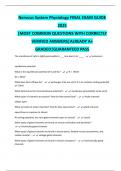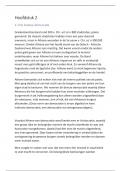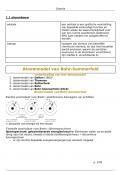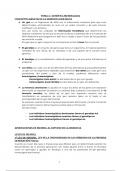Design and planning of production- 2021
Table of contents
Chapter 1 ....................................................................................................................................................2
Chapter 2 – Fundamentals of Continuous improvement ..........................................................................7
Chapter 3 – Value added and waste elimination. ....................................................................................13
Chapter 4 – Customer focused quality.....................................................................................................20
Chapter 5 – Small lot production .............................................................................................................28
Chapter 6 – Setup-time reduction ...........................................................................................................34
Chapter 7 – Maintaining and improving equipment................................................................................40
Chapter 8 – Pull production systems .......................................................................................................47
Chapter 9 – Focused factories and group technology .............................................................................55
Chapter 10 Work cells and cellular manufacturing..................................................................................61
Chapter 11 – Standard work ....................................................................................................................66
Chapter 12 – Quality at the source and mistake proofing .......................................................................69
Chapter 13 Production preparation process 3P.......................................................................................73
Chapter 14- Uniform flow and mixed-model scheduling .........................................................................76
Chapter 15 Synchronizing and balancing the process .............................................................................83
Chapter 16 Planning and control in pull production ................................................................................86
Chapter 17 - Lean production in the supply chain ...................................................................................92
1
,Chapter 1
What differentiates winners from losers is that winners are better able to consistently provide products
and services that are competitive with regard to quality (better), price (cheaper), time (faster), and
response to change (agile).
- As the number of skilled contenders in a given market increases, so does the intensity of the
competition.
Companies adopt different manufacturing philosophies and these differences are what distinguish lean
from traditional companies.
Traditional Lean
Making things better Heavy reliance on CAD to enhance Reliance on group tech and cellular
product design and manufacturing manufacturing, proper placement of
equipment, smaller manufacturing
units, and improvement-focused
employee teams.
Making things cheaper Reliance on job enlargement, Low cost approach through redesign
automation, robotics and simplification of products and
processes
Making things faster Reliance on robotics, flexible Emphasis on reduction of lead and
manufacturing systems, location of set up times, equipment
facilities and improved labor maintenance and broadening of
management relations. worker’s jobs.
Being more agile Agility through technology, process flow Agility as integral part of quality and
improvements. delivery capability and by product of
programs.
In traditional firms, product ideas tend to move sequentially through functional areas, whereas in lean
firms they are honed in production development teams.
Lean production and TQM
- Lean production is management that focuses the organization on continuously identifying and
removing sources of waste so that processes are continuously improved. Lean production is also
called just in time(JIT).
- TQM is management that focuses the organization on knowing the needs and wants of customers,
and on building capabilities to fulfill those needs and wants. Lean organizations greatly increase the
number of people involved in identifying and eliminating obstructions. Besides, the primary process
is reduction of inventory.
Lean production is a way of continuously tinkering so the pipeline and the material coming out of it are
the best possible. Lean production continuously seeks way to make the pipeline more adaptable to
whatever materials or flow rates are desired, to match the flow of materials as closely as possible to
customer demand, and to make the material coming out of the pipeline ever more acceptable to the
customer.
- Identifying the obstructions, understanding them and finding ways to eliminate them is the thrust
of lean production.
2
,Lean difference
Organizations seek to identify and eliminate obstructions in the pipeline, but two features distinguish
lean organizations.
1. lean organizations greatly increase the number of people involved in the effort whereas other
companies assign professionals to do it. In lean companies everyone is trained and involved so
their level of responsibility to make and carry out decisions is higher than elsewhere.
2. Practices employ to identify and prioritize problems.
In lean companies set difficult goals and look what the possible obstructions could be to meet
them.
o Inventory reduction is not the ultimate objective but a mean to identify problems and waste.
Inventory reduction frees capital but if problems are not resolved, companies fail.
Evolution of manufacturing
The first change in the auto industry came after WWI when Henry Ford and Alfred Sloan advanced
manufacturing from craft production to mass production. The second change came after WWII when
Toyota Motor Company pioneered lean production.
Craftmanship yields to industrialization
With the implementation of the interchangeable part in production of products, the slow transformation
that would replace hand labor and craftsmanship with mechanization and division of labor began.
Interchangeable parts are made in batches such that any one part would fall within design tolerances
and fit into an assembled product.
Frederick Taylor introduced the idea of improving operations by studying and simplifying them. Always
looking for the one best way to do something. One consequence of this theory was to take most of the
skills and thinking away from factory workers and give them to legions of managers and specialists.
- This led to the theory of scientific management. In which most of the skills and thinking was taken
away from factory workers and given to managers and specialists.
Workers were stripped of all control and had to perform repetitive tasks which resulted in a lack of
commitment from the employees.
Craft production of automobile
Cars were poor in terms of consistency, reliability, and drivability as there was a lack of uniformity in the
parts produced and they had to be adjusted to fit each individual car.
Ford’s mass production system
Ford introduced a moving assembly line which brought the cars past stationary workers, eliminated
time wasted by workers walking and forced slower workers to keep up with the pace of the line.
The system of mass production today is largely a result of the combined influence of Ford, Sloan and
organized labor.
- Ford used Taylor’s theory to the extreme and employees moved from doing a whole range of tasks
to just doing one and all the thinking was delegated to management.
3
, Emergence of mass production
The system of mass production today is largely a result of the combined influence of Ford, Sloan, and
organized labor.
- Unions emerged as employees were largely treated as expendable commodities.
Mass production around the world- Toyota production system
The system Toyota developed, called the Toyota Production System, is the prototype for lean
production and Just in Time manufacturing. Though developed for automobile production, the
principles of the system have since been applied in all kind of industries.
- Reduced setup times: if a setup takes a long time, it would be necessary to produce things in large
batches to justify that setup time. Since setup times were usually long, large batch production
became the norm in manufacturing.
- Small batch production and One Piece flow: producing things in large batches results in larger
inventories because it takes longer to use up the batch and that results in higher holding costs. The
classical way to determine optimal batch size is based on the economic order quantity (EOQ)
formula: EOQ= √2DS/H , where: D is demand, S is setup costs, and H is holding costs.
It became possible for Toyota to economically produce a variety of things in small quantities. The
smallest size demand is one unit, and Toyota set the goal of being able to produce anything, one
unit at a time. This is called one piece flow.
- Employee involvement and empowerment: Ohno organized his workers by forming teams, and
gave them responsibility and training to do many specialized tasks. They were allowed time to meet
to discuss problems and find ways to improve the process. The notion of workers asking why five
times to get to problem root causes was first introduced at Toyota.
- Quality at the source: Ohno reasoned that to eliminate product defects, defects must be discovered
and corrected as soon as possible, which means going to the source of defects and stopping them
there. If the defect could not be readily fixed, any worker could halt the entire line by pulling a cord:
andon/line stop.
o Equipment maintenance: operators are assigned primary responsibility for basic preventive
maintenance since they are in the best position to detect early signs of malfunction.
o Pull production: to reduce waste Ohno developed the pull production method wherein the
quantity of work performed at each stage of the process is dictated solely by the demand
for materials from the immediate next stage. The flow of materials was coordinated using
Kanban so that just as a container was used up, a full container from the previous stage
would arrive to replenish it (origin of JIT).
o Standard work: a concept wherein worker teams create the standards that define the work
they currently do. The standard work also serves as the baseline from which to improve
processes to better suit changes in customer demand and the work environment.
o Supplier partnerships: Ohno saw the need for a different kind of relationship wherein the
manufacturer treats its suppliers as partners and integral elements of the production
system. Essentially, suppliers are trained in ways to reduce setup times, inventories, defects,
machine breakdowns, and in return they take responsibility for delivering the best possible
parts/services to the manufacturer in a timely manner.
4
Table of contents
Chapter 1 ....................................................................................................................................................2
Chapter 2 – Fundamentals of Continuous improvement ..........................................................................7
Chapter 3 – Value added and waste elimination. ....................................................................................13
Chapter 4 – Customer focused quality.....................................................................................................20
Chapter 5 – Small lot production .............................................................................................................28
Chapter 6 – Setup-time reduction ...........................................................................................................34
Chapter 7 – Maintaining and improving equipment................................................................................40
Chapter 8 – Pull production systems .......................................................................................................47
Chapter 9 – Focused factories and group technology .............................................................................55
Chapter 10 Work cells and cellular manufacturing..................................................................................61
Chapter 11 – Standard work ....................................................................................................................66
Chapter 12 – Quality at the source and mistake proofing .......................................................................69
Chapter 13 Production preparation process 3P.......................................................................................73
Chapter 14- Uniform flow and mixed-model scheduling .........................................................................76
Chapter 15 Synchronizing and balancing the process .............................................................................83
Chapter 16 Planning and control in pull production ................................................................................86
Chapter 17 - Lean production in the supply chain ...................................................................................92
1
,Chapter 1
What differentiates winners from losers is that winners are better able to consistently provide products
and services that are competitive with regard to quality (better), price (cheaper), time (faster), and
response to change (agile).
- As the number of skilled contenders in a given market increases, so does the intensity of the
competition.
Companies adopt different manufacturing philosophies and these differences are what distinguish lean
from traditional companies.
Traditional Lean
Making things better Heavy reliance on CAD to enhance Reliance on group tech and cellular
product design and manufacturing manufacturing, proper placement of
equipment, smaller manufacturing
units, and improvement-focused
employee teams.
Making things cheaper Reliance on job enlargement, Low cost approach through redesign
automation, robotics and simplification of products and
processes
Making things faster Reliance on robotics, flexible Emphasis on reduction of lead and
manufacturing systems, location of set up times, equipment
facilities and improved labor maintenance and broadening of
management relations. worker’s jobs.
Being more agile Agility through technology, process flow Agility as integral part of quality and
improvements. delivery capability and by product of
programs.
In traditional firms, product ideas tend to move sequentially through functional areas, whereas in lean
firms they are honed in production development teams.
Lean production and TQM
- Lean production is management that focuses the organization on continuously identifying and
removing sources of waste so that processes are continuously improved. Lean production is also
called just in time(JIT).
- TQM is management that focuses the organization on knowing the needs and wants of customers,
and on building capabilities to fulfill those needs and wants. Lean organizations greatly increase the
number of people involved in identifying and eliminating obstructions. Besides, the primary process
is reduction of inventory.
Lean production is a way of continuously tinkering so the pipeline and the material coming out of it are
the best possible. Lean production continuously seeks way to make the pipeline more adaptable to
whatever materials or flow rates are desired, to match the flow of materials as closely as possible to
customer demand, and to make the material coming out of the pipeline ever more acceptable to the
customer.
- Identifying the obstructions, understanding them and finding ways to eliminate them is the thrust
of lean production.
2
,Lean difference
Organizations seek to identify and eliminate obstructions in the pipeline, but two features distinguish
lean organizations.
1. lean organizations greatly increase the number of people involved in the effort whereas other
companies assign professionals to do it. In lean companies everyone is trained and involved so
their level of responsibility to make and carry out decisions is higher than elsewhere.
2. Practices employ to identify and prioritize problems.
In lean companies set difficult goals and look what the possible obstructions could be to meet
them.
o Inventory reduction is not the ultimate objective but a mean to identify problems and waste.
Inventory reduction frees capital but if problems are not resolved, companies fail.
Evolution of manufacturing
The first change in the auto industry came after WWI when Henry Ford and Alfred Sloan advanced
manufacturing from craft production to mass production. The second change came after WWII when
Toyota Motor Company pioneered lean production.
Craftmanship yields to industrialization
With the implementation of the interchangeable part in production of products, the slow transformation
that would replace hand labor and craftsmanship with mechanization and division of labor began.
Interchangeable parts are made in batches such that any one part would fall within design tolerances
and fit into an assembled product.
Frederick Taylor introduced the idea of improving operations by studying and simplifying them. Always
looking for the one best way to do something. One consequence of this theory was to take most of the
skills and thinking away from factory workers and give them to legions of managers and specialists.
- This led to the theory of scientific management. In which most of the skills and thinking was taken
away from factory workers and given to managers and specialists.
Workers were stripped of all control and had to perform repetitive tasks which resulted in a lack of
commitment from the employees.
Craft production of automobile
Cars were poor in terms of consistency, reliability, and drivability as there was a lack of uniformity in the
parts produced and they had to be adjusted to fit each individual car.
Ford’s mass production system
Ford introduced a moving assembly line which brought the cars past stationary workers, eliminated
time wasted by workers walking and forced slower workers to keep up with the pace of the line.
The system of mass production today is largely a result of the combined influence of Ford, Sloan and
organized labor.
- Ford used Taylor’s theory to the extreme and employees moved from doing a whole range of tasks
to just doing one and all the thinking was delegated to management.
3
, Emergence of mass production
The system of mass production today is largely a result of the combined influence of Ford, Sloan, and
organized labor.
- Unions emerged as employees were largely treated as expendable commodities.
Mass production around the world- Toyota production system
The system Toyota developed, called the Toyota Production System, is the prototype for lean
production and Just in Time manufacturing. Though developed for automobile production, the
principles of the system have since been applied in all kind of industries.
- Reduced setup times: if a setup takes a long time, it would be necessary to produce things in large
batches to justify that setup time. Since setup times were usually long, large batch production
became the norm in manufacturing.
- Small batch production and One Piece flow: producing things in large batches results in larger
inventories because it takes longer to use up the batch and that results in higher holding costs. The
classical way to determine optimal batch size is based on the economic order quantity (EOQ)
formula: EOQ= √2DS/H , where: D is demand, S is setup costs, and H is holding costs.
It became possible for Toyota to economically produce a variety of things in small quantities. The
smallest size demand is one unit, and Toyota set the goal of being able to produce anything, one
unit at a time. This is called one piece flow.
- Employee involvement and empowerment: Ohno organized his workers by forming teams, and
gave them responsibility and training to do many specialized tasks. They were allowed time to meet
to discuss problems and find ways to improve the process. The notion of workers asking why five
times to get to problem root causes was first introduced at Toyota.
- Quality at the source: Ohno reasoned that to eliminate product defects, defects must be discovered
and corrected as soon as possible, which means going to the source of defects and stopping them
there. If the defect could not be readily fixed, any worker could halt the entire line by pulling a cord:
andon/line stop.
o Equipment maintenance: operators are assigned primary responsibility for basic preventive
maintenance since they are in the best position to detect early signs of malfunction.
o Pull production: to reduce waste Ohno developed the pull production method wherein the
quantity of work performed at each stage of the process is dictated solely by the demand
for materials from the immediate next stage. The flow of materials was coordinated using
Kanban so that just as a container was used up, a full container from the previous stage
would arrive to replenish it (origin of JIT).
o Standard work: a concept wherein worker teams create the standards that define the work
they currently do. The standard work also serves as the baseline from which to improve
processes to better suit changes in customer demand and the work environment.
o Supplier partnerships: Ohno saw the need for a different kind of relationship wherein the
manufacturer treats its suppliers as partners and integral elements of the production
system. Essentially, suppliers are trained in ways to reduce setup times, inventories, defects,
machine breakdowns, and in return they take responsibility for delivering the best possible
parts/services to the manufacturer in a timely manner.
4








